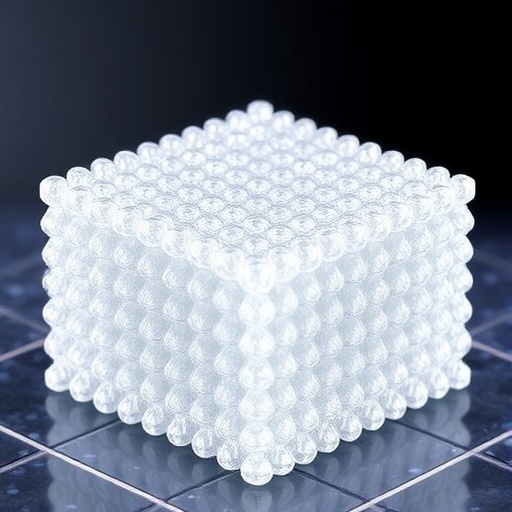In the ongoing global battle against climate change, the capture and conversion of carbon dioxide (CO2) into valuable products represents a critical scientific frontier. Conventional chemical reactors face significant limitations due to thermodynamic equilibrium and sluggish reaction kinetics, which temper the efficiency of CO2 conversion processes. To surmount these barriers, researchers have turned their attention to innovative membrane reactor technologies that promise to enhance reaction yields through strategic manipulation of reaction equilibria.
Recent groundbreaking work led by Associate Professor Yuichiro Hirota at Nagoya Institute of Technology introduces an advanced membrane system designed to address the intrinsic challenges of CO2 conversion reactions. The team’s development centers on zeolitic ZSM-5 membranes modified with a silsesquioxane framework embedding ionic liquids (SQILs), engineered to optimize selective water vapor removal while suppressing hydrogen permeation under demanding high-temperature and low-water-concentration conditions.
Traditional reactors often are trapped in equilibrium, where reactants like hydrogen (H2) and CO2 coexist with products, limiting the amount of methanol, carbon monoxide, or synthetic fuels produced. Increasing temperature and pressure to accelerate conversion and shift equilibrium can lead to prohibitive energy costs, undermining the sustainability of these processes. Membrane reactors, particularly those incorporating hydrophilic membranes capable of selectively removing water—a byproduct—offer an elegant solution by continuously shifting the chemical equilibrium towards product formation without the need for energy-intensive operational parameters.
ZSM-5, a microporous aluminosilicate zeolite known for its selective adsorption properties, has emerged as a promising candidate for membrane reactors due to its ability to adsorb water molecules within its pore structures. However, under industrially relevant conditions characterized by high temperature (~473 K) and low water concentrations, conventional ZSM-5 membranes falter. Their pore-blocking capability deteriorates, allowing undesirable H2 permeation and thus compromising selectivity and conversion efficiency.
Addressing this conundrum, Dr. Hirota’s team synthesized two varieties of ionic-liquid-containing silsesquioxane frameworks by polymerizing 1-methyl-3-(1-triethoxysilylpropyl)imidazolium (Sipmim) cations paired with different anions: trifluoromethanesulfonate (OTf–) forming polySipmimOTf, and bis(trifluoromethylsulfonyl)imide (Tf2N–) forming polySipmimTf2N. Notably, polySipmimOTf exhibited superior hydrophilicity compared to its counterpart, an essential characteristic for augmenting water selectivity.
The researchers prepared two types of ZSM-5 membranes distinguished by their cation types: sodium-ion (Na+) exchanged NaZ-5, imparting hydrophilicity, and hydrogen-ion (H+) exchanged HZ-5, which is relatively less hydrophilic. Modification with the SQILs was applied to these membranes, producing hybrid structures evaluated for hydrogen permeation and water permselectivity under controlled experimental setups at 473 K.
Experimental results revealed that membranes modified with SQILs substantially suppressed hydrogen permeation while elevating water permselectivity relative to unmodified ZSM-5 membranes. Importantly, those incorporating polySipmimOTf demonstrated markedly better performance than membranes modified with polySipmimTf2N. Among these, the OTf–/NaZ-5 membranes stood out for achieving the highest water permselectivity, surpassing even OTf–/HZ-5 variants, pinpointing the critical influence of membrane hydrophilicity in coordination with SQIL properties.
One of the most significant advancements reported is the retention of low hydrogen permeability by SQIL-modified membranes even when subjected to very dilute water vapor environments—conditions notoriously challenging for conventional membranes. Simultaneously, these membranes maintained high water permeation efficiency at elevated water concentrations. This dual capability is attributed to a synergistic interplay between SQIL and ZSM-5 layers, which collectively facilitate selective adsorption and capillary condensation phenomena within the microporous network.
Dr. Hirota elucidates that the enhanced dehydration performance stems from three principal factors: first, the inherently low hydrogen solubility and pronounced hydrophilicity of the SQIL layer dramatically reduce hydrogen crossover; second, the ZSM-5 micropores actively adsorb and condense water vapor, leveraging their molecular sieving effect; and third, the SQIL modifies water sorption behavior, transforming it from typical Langmuir adsorption isotherms toward Henry’s law characteristics, indicative of enhanced linear sorption dynamics.
The implications of these findings extend profoundly into the wider context of carbon-neutral fuel and chemical production. By integrating membranes capable of efficiently and selectively removing water at the reaction interface, membrane reactors can overcome equilibrium constraints and drive higher yields without resorting to energy-intensive operational conditions. This strategy thus aligns perfectly with sustainability goals by reducing energy input while maximizing CO2 utilization rates.
The research from Nagoya Institute of Technology also highlights the importance of material design at the molecular level. The innovative use of ionic-liquid-modified silsesquioxane frameworks signifies a leap forward in membrane engineering, showcasing how finely tuned hybrid materials can overcome traditional material limitations under real-world operating stresses. Moreover, this work sets a precedent for further exploration of ionic liquids and polymeric frameworks in enhancing membrane selectivities for various catalytic and separation processes.
Looking ahead, the adoption of such advanced membranes in industrial-scale membrane reactors could drive a transformative shift in how chemical industries approach CO2 conversion and energy efficiency. By enabling more practical and effective membrane separation under harsh conditions, these materials could not only reduce operational costs but also mitigate greenhouse gas emissions, thereby playing a pivotal role in global efforts against climate change.
The publication of this research in the prestigious Journal of Membrane Science underscores its significance to the membrane science community and related industrial sectors. It represents a convergence of materials chemistry, chemical engineering, and environmental science aimed at delivering tangible solutions to pressing global challenges.
In summation, the silsesquioxane framework containing ionic-liquid-modified NaZSM-5 membranes developed by Dr. Hirota and colleagues epitomizes the cutting-edge of membrane technology for sustainable chemical manufacturing. With their improved hydrogen-water separation performance at elevated temperatures and low water vapor concentrations, these membranes chart a promising path toward more efficient and environmentally responsible CO2 conversion technologies.
Subject of Research: Not applicable
Article Title: Silsesquioxane framework containing ionic liquid−modified NaZSM-5 membrane for H2O/H2 separation at high temperature
News Publication Date: 1-Nov-2025
Web References: https://doi.org/10.1016/j.memsci.2025.124568
Image Credits: Yuichiro Hirota from Nagoya Institute of Technology, Japan
Keywords
Carbon dioxide conversion, membrane reactors, ZSM-5, silsesquioxane frameworks, ionic liquids, hydrogen permeation, water permselectivity, catalytic reaction engineering, gas separation membranes, nanoporous materials, environmental sustainability, CO2 utilization
Tags: CO2 conversion efficiencyenhanced reaction yieldshigh-temperature CO2 conversionhydrogen permeation suppressioninnovative chemical reactorsionic liquid-modified zeolite membranesmembrane reactor technologiesselective water vapor removalsilsesquioxane framework in membranessustainable carbon capture methodsthermodynamic equilibrium challengeszeolitic ZSM-5 membranes





